Some birds are ‘smarter’ than others, or at least their feeding strategies seem to be more effective in difficult situations.
This is what I woke up to yesterday morning, a spring snowstorm that left about 3″ of snow in my back yard and significantly more in other parts of the Salt Lake Valley. Here the snow looks blue-ish because the photo was taken with my cell phone before sunrise. The forecast was for clouds and more snow for the rest of the day so I didn’t go shooting.
About midmorning, on my way home from buying groceries, I decided on a whim to visit a local park to look for birds feeding on last year’s shriveled up crabapples. I didn’t have my big lens with me but I always carry my ‘baby lens’ in my pickup so if I found any birds I could at least document any interesting avian surprises I stumbled upon. Or I could go home and quickly grab my big lens. It was mostly cloudy so I didn’t have any real hope for quality photos.
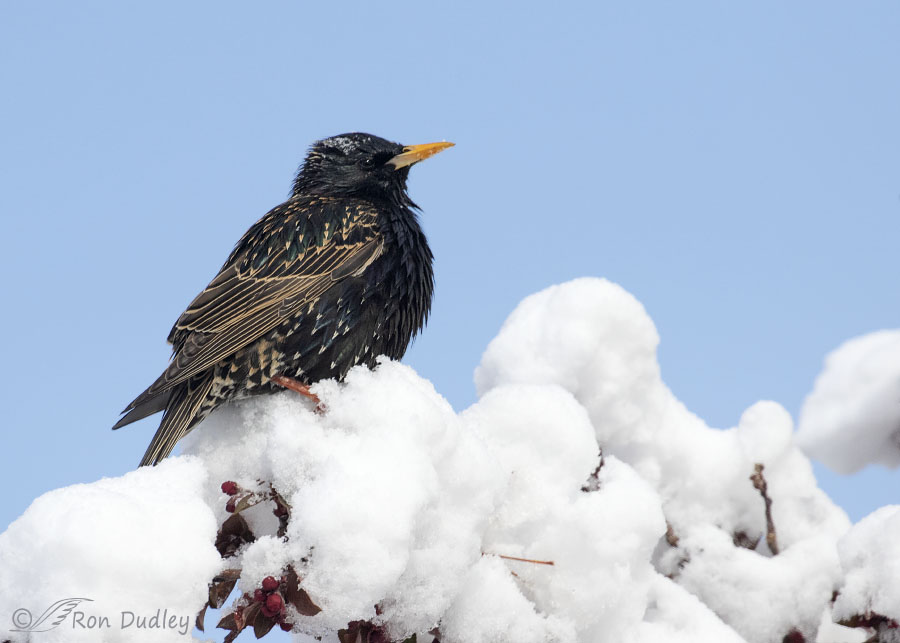
1/2500, f/6.3, ISO 500, Canon 7D Mark II, EF 100-400mm f/4.5-5.6L IS II USM @ 400mm, not baited, set up or called in
I found European Starlings and American Robins feeding, or attempting to feed, on the snow-covered crabapples (there’s a ‘suckerhole’ of blue sky behind the starling but most of the sky was cloudy). This time of year, when there isn’t any snow, the crabapples that have fallen to the ground are easy pickin’s for birds. But with that much snow on the ground the fallen crabapples can’t be seen, much less found and eaten, so the birds were trying to find them and eat them in the snow-covered trees.
Most or all of the starlings were using the same strategy. They were perched on the tops of the trees and trying to find and reach crabapples through all of that snow. Good luck with that!
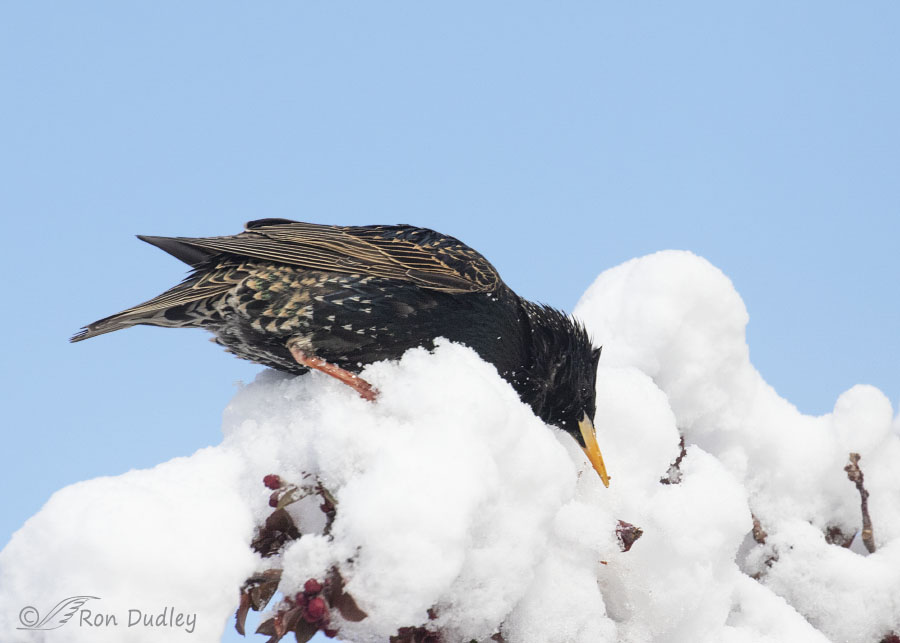
1/4000, f/6.3, ISO 500, Canon 7D Mark II, EF 100-400mm f/4.5-5.6L IS II USM @ 400mm, not baited, set up or called in
This was the only starling that I saw actually eat a crabapple but ‘he’…
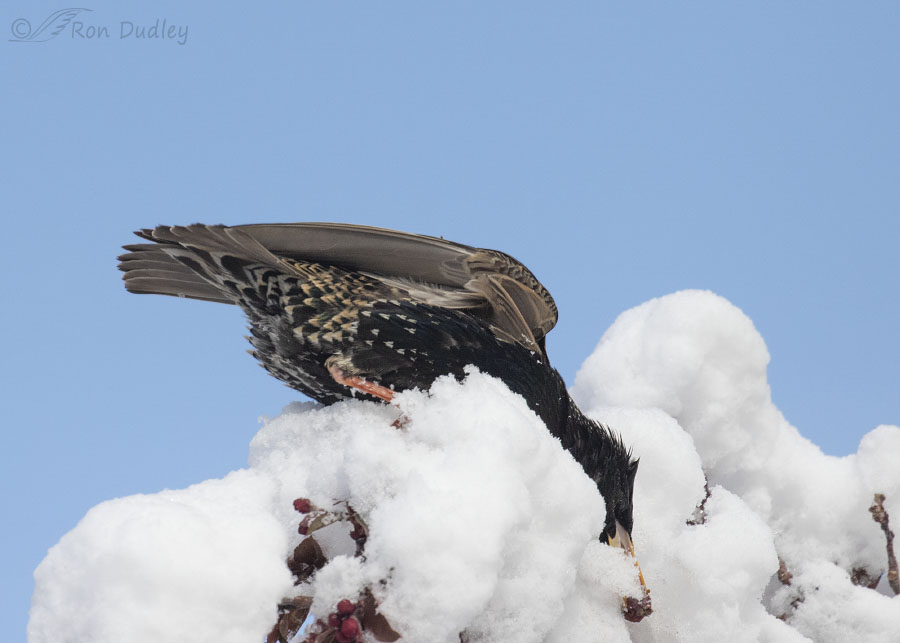
1/4000, f/6.3, ISO 500, Canon 7D Mark II, EF 100-400mm f/4.5-5.6L IS II USM @ 400mm, not baited, set up or called in
really had to work at finding and reaching it. I had no idea a starling could stretch its neck this far. Most of the other starlings just seemed to perch on the tops of the small trees in apparent hunger and frustration.
I’ve presented these three starling photos out of order. Photo #1 was taken after photo #2 and #3, as evidenced by the crabapple stem without a crabapple on it and the snow on top of the starling’s head in photo #1.
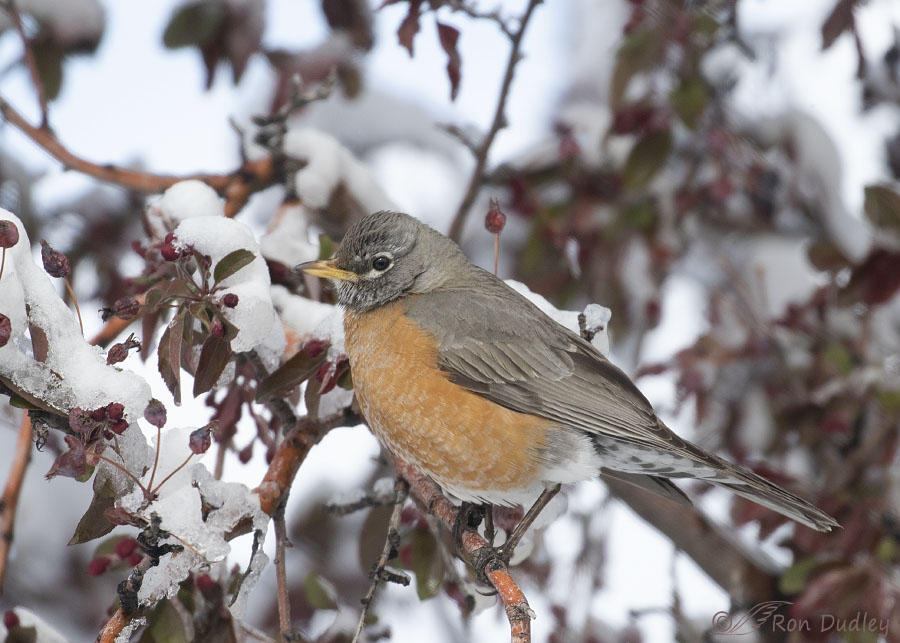
1/2000, f/6.3, ISO 500, Canon 7D Mark II, EF 100-400mm f/4.5-5.6L IS II USM @ 400mm, not baited, set up or called in
But the feeding strategy of the robins was different and more effective. They perched in the lower branches of the trees close to the trunks where there was much less snow to hide the crabapples. And whenever they felt the urge they would pick off one of the many shriveled fruits available to them down there.
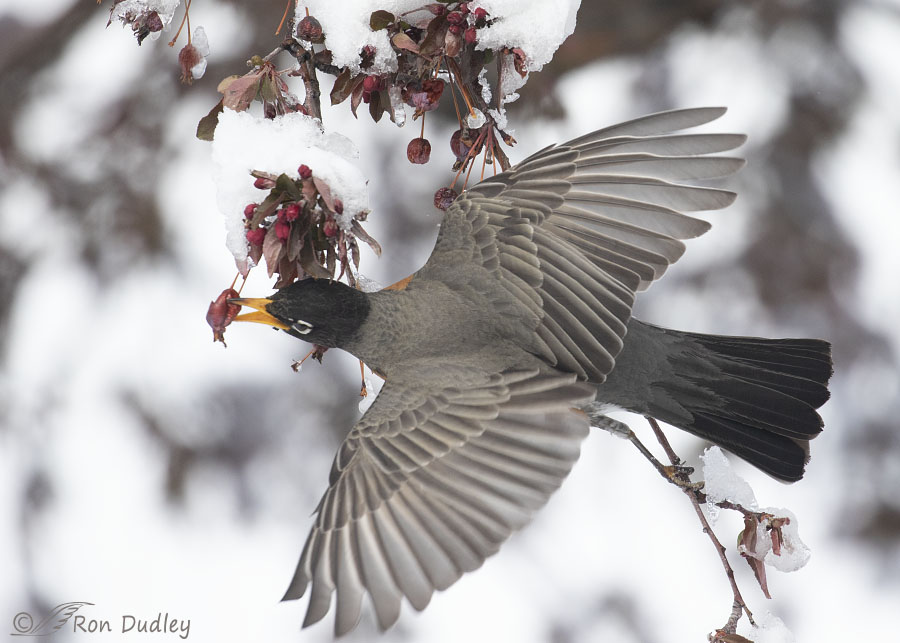
1/1600, f/6.3, ISO 500, Canon 7D Mark II, EF 100-400mm f/4.5-5.6L IS II USM @ 400mm, not baited, set up or called in
The only problem the robins had was getting the crabapples off of the stems. They’re hard to pull off so they had to work at it.
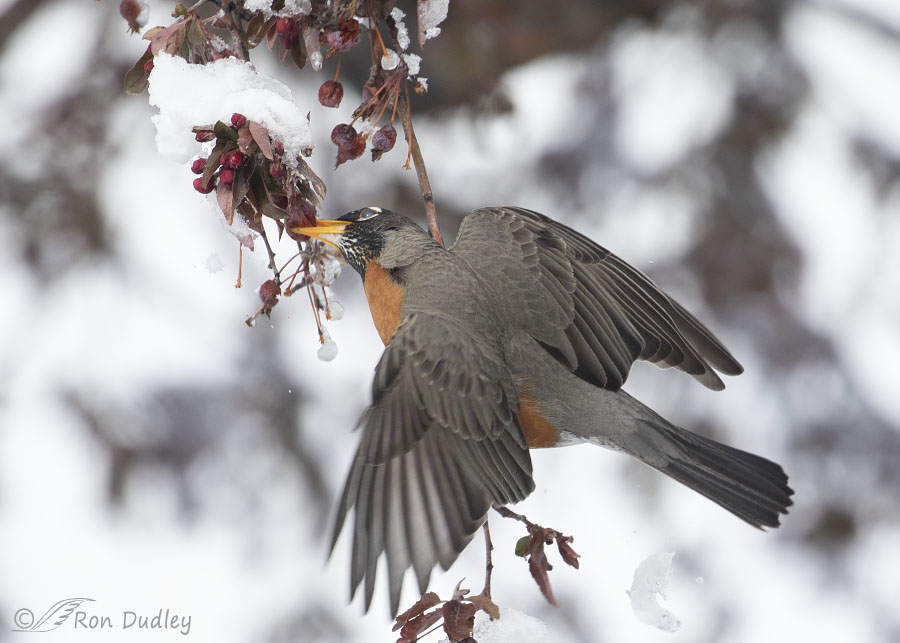
1/1600, f/6.3, ISO 500, Canon 7D Mark II, EF 100-400mm f/4.5-5.6L IS II USM @ 400mm, not baited, set up or called in
Here the robin is twisting the stem one way and then…
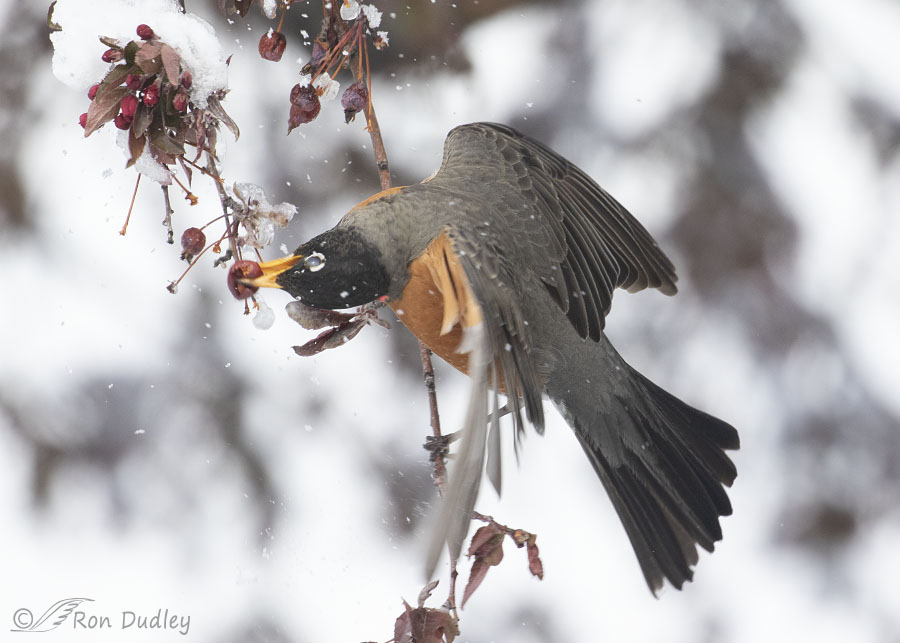
1/2500, f/6.3, ISO 500, Canon 7D Mark II, EF 100-400mm f/4.5-5.6L IS II USM @ 400mm, not baited, set up or called in
yanking it another.
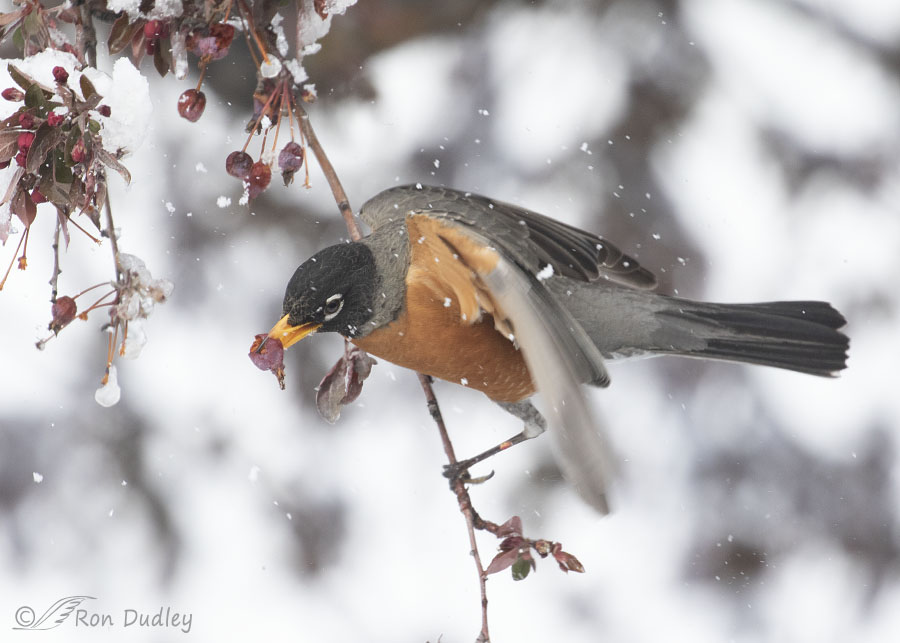
1/1600, f/6.3, ISO 500, Canon 7D Mark II, EF 100-400mm f/4.5-5.6L IS II USM @ 400mm, not baited, set up or called in
And it worked.
The robin enjoyed its snack amongst the many other crabapples that it could pick off at its leisure. I never once saw a starling using this more effective feeding strategy. They just stayed at the top of the trees and occasionally tried to find a crabapple, usually without success from what I saw.
But then I wasn’t there for very long so maybe the starlings figured it out after I left.
Ron


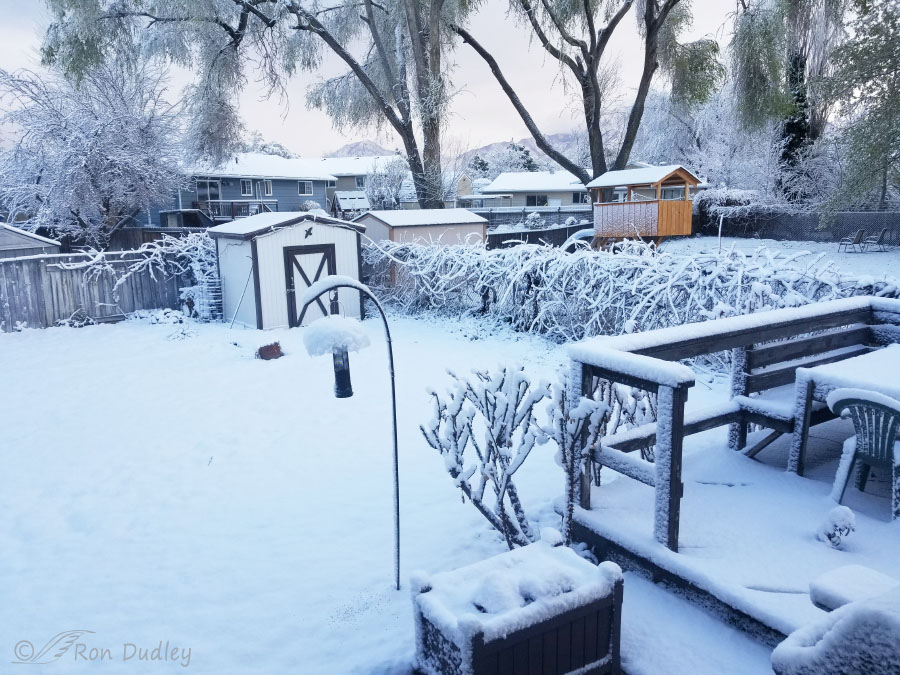
It’s always a treat to see your Harrier photos. Extra points for the banding.
If I could get up as early as you I would do my best to scold you via the comment section to not leave your R-5 and big lens at home. Second time this week you’ve done that. Tsk, tsk. There’ll be detention if it happens again and you will be made to write: “Luck is what happens when preparation meets opportunity” 500 times to match your 500mm lens.
Lyle, it isn’t worth the risk to have my big gear in the pickup when I’m doing chores and shopping etc. Smash and grab folks would love to get their hands on my expensive gear.
So interesting to see the two different foraging strategies. Looks like the robin made use of its nictitating membrane as it was twisting the fruit off the stem.
It’s weird to see snow in your yard when it was over 100 in my yard just a week ago. Glad you guys are getting a little more water, though.
Marty, we’ve had temps of nearly 80° more than once recently and then snow and nighttime temps in the 20’s and highs in the 40’s. Springtime in Utah!
Yay! First time in several weeks I’ve had access to your blog via my phone. Love this story on feeding strategies. Anther reason to dislike starlings then, they’re not too bright. Or, perhaps, where food was more plentiful there wouldn’t have been any opportunity to fight over it? And what starling would give up the opportunity for a fight?
Their iridescence can make them prettier than a robin, and their pugnacious behaviour can lead to more interesting wing action shots than the usual Robin placidly sitting or hopping or pulling on a worm shot but nice to know robins are smarter. I’ve never seen Robin’s exhibit such interesting wing action or feeding smarts so this was a pleasant surprise.
I love the serene atmosphere in the “snow before sunrise” picture. There’s a pristine freshness to it that can only be experienced before it’s broken by the fuss and noise of people waking up and going about their day. Good morning!
You’ve described the mood of that snowy scene well, Amy.
Great behavior series.
Thanks, April.
A wonderful documentary series. I do hope that the starlings learned this much more effective technique. All praise to the far from bird-brained robins.
Thanks, EC. Glad you enjoyed it.
Leave it to you to stop and photograph birds after getting groceries. Glad you did, though. We make a beeline home so things won’t melt, but then it’s a half hour trip. Strange spring we’re having. We’re having rain, then sun, then rain and sun simultaneously, but no snow.
Lyle, getting groceries is only a three minute drive for me to get there. And the park is close too. I’m lucky in that way.
Wonderful and beautiful photos Ron. Even like the yard photo. The Starling shot with the bit of snow on its head is my favorite. Thank you!
Thanks a lot, Michael.
I really enjoyed your post today, Ron. I’ve always been intrigued by how birds survive in inclement conditions and observing this particular behavior through your photos is fascinating. I always feel bad for the birds that come back to Teton Valley WAY too early, as there is likely to be snow and cold into May. Though, I must admit that I love photos of birds in the snow!
I know what you mean, Marya. We occasionally get snow in the valley’s in May around here too but not nearly as often as you do.
Wonderful! That profile of the robin is the perfect Christmas holiday greeting card. And the gyrations to get that fruit. So fun.
Ha, I guess I’ll have to remember that shot when I’m looking for a photo to post next Christmas. Thanks, Cathryn.
Occasionally we get one of these surprise spring snowstorms and I have seen the birds outback doing the same thing on our Crabapple. Some nice shots here of both the Starling and the Robin. Like the ones with the wings fanned out. Hopefully this will melt away fairly soon so you can get back out there with the R5.
Thanks, Everett. I’m afraid our forecast for the next few days doesn’t hold much promise.
I liked the really good look at the robin’s open-fanned wings– lovely against the snow….it occurred me to wonder if robins are generally better at individual
pursuits than are starlings, which seem mostly to function within very large
gatherings, doing as their neighbors do ? And if they don’t have clever
neighbors, they just have to struggle…..and speaking of neighbors, looks
like you have a very dedicated arborist living next to you–lovely openings on
those trees !
Kris, from what I’ve observed in the 30 years I’ve lived here, the “arborist” has been mostly heavy snow and wind that breaks off heavy limbs. When they crack it sounds almost like thunder. They’ve been lucky, so far, to not have any of them fall on the houses, sheds, trampolines or play forts.
I’m so glad my big elm tree is gone! It was a disaster waiting to happen.
Both sides of the street on the other side of those houses is lined with Bradford Pear trees and many of their limbs came down from the weight of the snow in this storm. Yesterday morning when I went grocery shopping that street was covered with broken limbs. Bradford Pear trees are known for being brittle, among other things.
And I thought Starlings were smart! I enjoyed your observations today. Thank you!!
Maybe the starlings figured it out, Richard. My observation was short but I’m reporting what I saw at the time.
Fun photos documenting the strategy of the different birds. Robins always seem to arrive here before at least one big storm and seem to do fine tho I’ve never really paid attention to feeding strategy. Not many Starlings and not in the yard so don’t know.
Robins always seem to arrive here before at least one big storm and seem to do fine tho I’ve never really paid attention to feeding strategy. Not many Starlings and not in the yard so don’t know.
Few inches of snow and 16 this morning. Southern part of the State REALLY got hammered. Hwy 94 from Billings to James Town still closed this morning with a lot of severe driving N & S of that.
Thanks, Judy. We sometimes have at least a few robins through most of the winter but this winter they seemed to be absent. Good to have them back.
Sweet Starling and Robin crab apple feeding frenzy! You had a bit more snow than I did. It was fun being home and watching birds in my front yard too.
I’m glad you’re enjoying the birds, Brett. Warms the heart of this former teacher of yours…